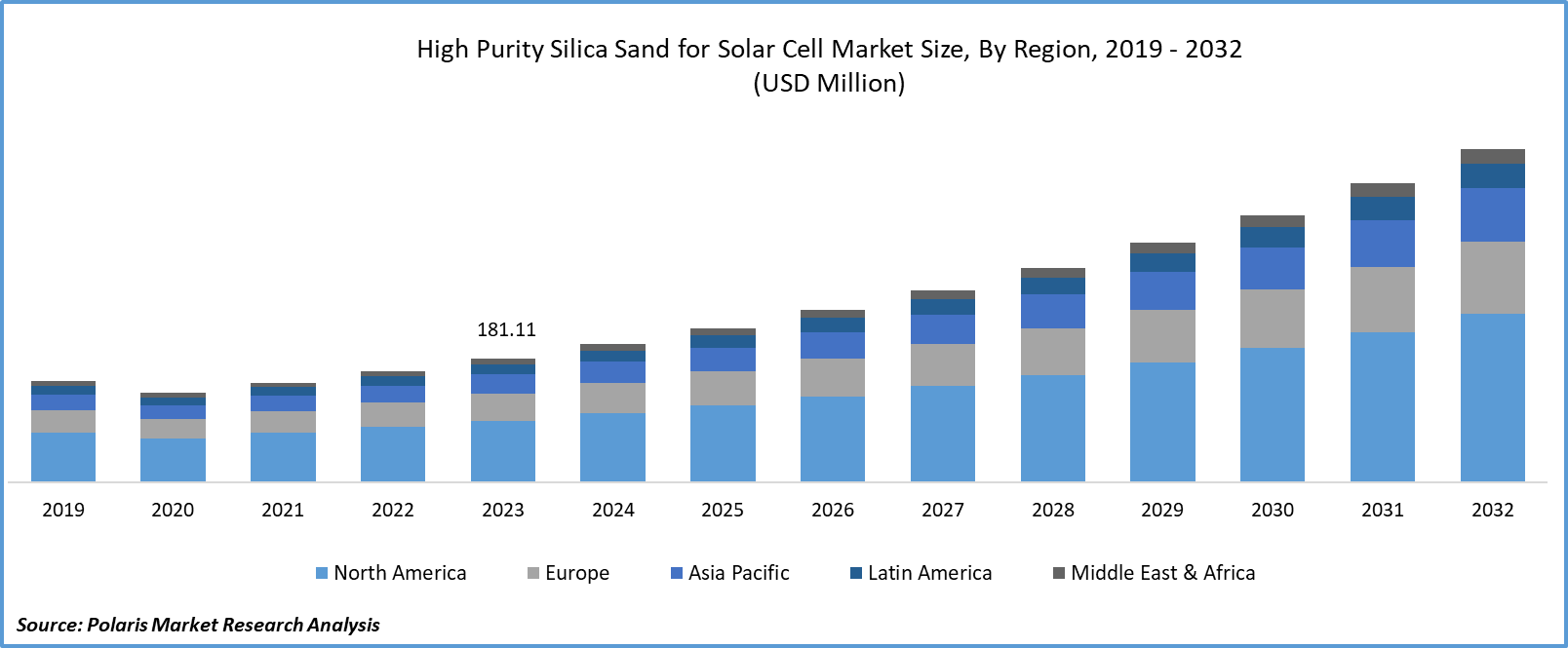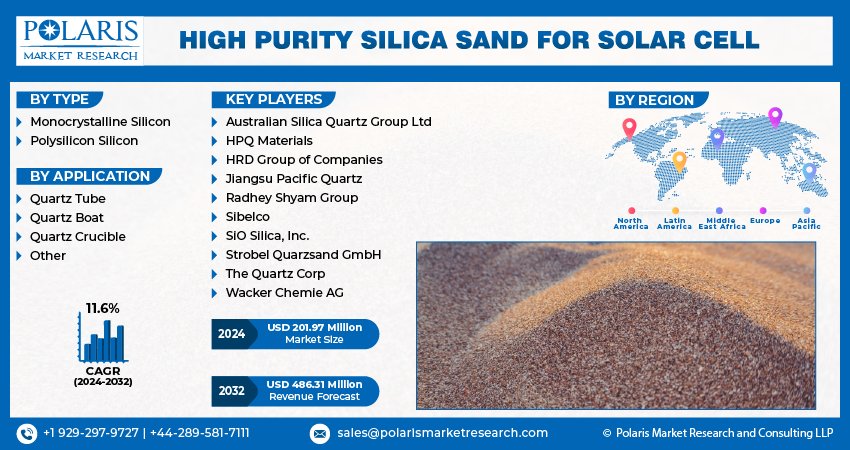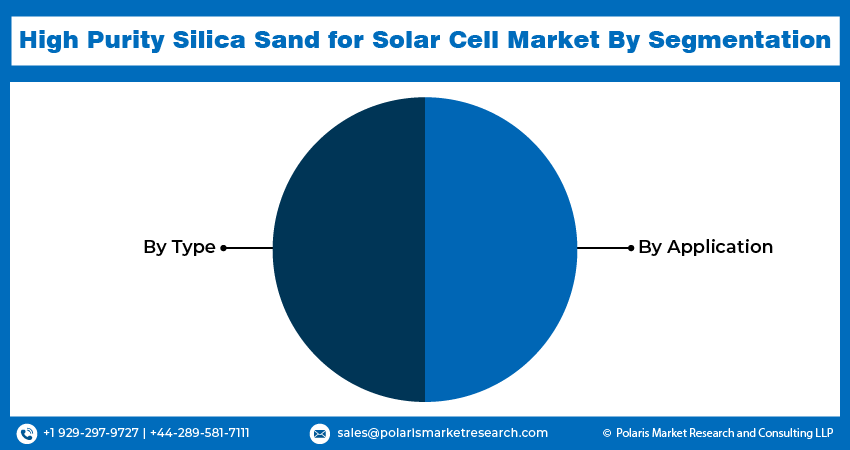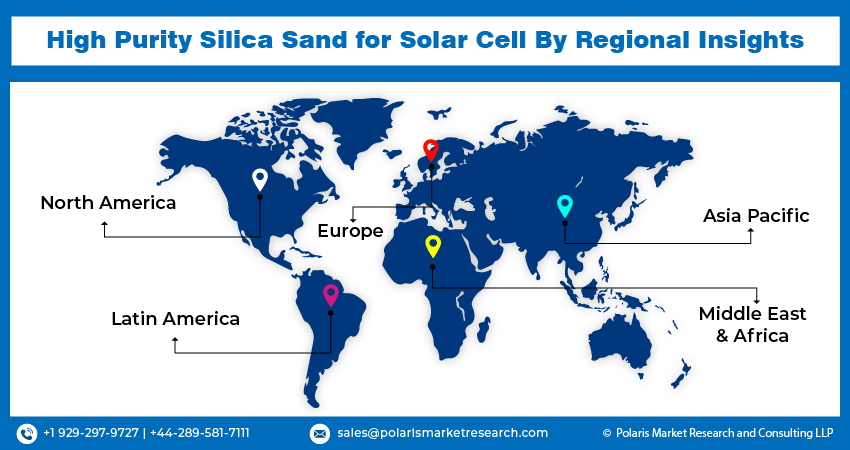
High Purity Silica Sand for Solar Cell Market Share, Size, Trends, Industry Analysis Report, By Type (Monocrystalline Silicon, Polysilicon Silicon); By Applications; By Region; Segment Forecast, 2024- 2023
- Published Date:Feb-2024
- Pages: 118
- Format: PDF
- Report ID: PM4656
- Base Year: 2023
- Historical Data: 2019-2022
Report Outlook
Global high purity silica sand for solar cell market size was valued at USD 181.11 million in 2023. The market is anticipated to grow from USD 201.97 million in 2024 to USD 486.31 million by 2032, exhibiting a CAGR of 11.6% during the forecast period.
Industry Trend
The high purity silica sand for solar cell market refers to the industry associated with the production, processing, and supply of high-purity silica sand specifically designed for use in the manufacturing of solar cells. Silica sand is a key raw material in the production of solar panels or photovoltaic (PV) cells. The characteristics of high-purity silica sand make it suitable for use in the solar industry. High purity is essential to ensure the optimal performance of solar cells. The sand is used in the manufacturing of silicon, which is a critical component of solar cells. The semiconductor-grade silicon derived from high-purity silica is crucial for the production of efficient and high-performance solar panels.
The surge in demand for superior materials in solar photovoltaic (PV) manufacturing propels the high purity silica sand for solar cell market. This specialized silica sand plays a crucial role in producing silicon wafers, essential components in the fabrication of solar cells. The rising embrace of solar energy shapes the market's expansion as a sustainable and renewable power solution. The quest for dependable and high-purity silica sand for solar cells significantly contributes to the upward trajectory of this market.

To Understand More About this Research: Request a Free Sample Report
Solar cell manufacturing requires high-quality materials to ensure the efficiency and reliability of the solar panels. High-purity silica sand meets the stringent quality standards necessary for solar applications. The semiconductor industry demands silica with very low impurity levels, as impurities can affect the electrical properties of silicon. High-purity silica ensures the desired chemical composition and electrical characteristics required for solar cells.
The expansion of the solar energy sector, driven by the global push for renewable energy sources, significantly contributes to the scope of the high purity silica sand for solar cell market. The increasing installation of solar power systems and the growing demand for efficient solar panels create a substantial market opportunity. Ongoing advancements in solar cell technology often necessitate higher-purity materials. The scope of the market is influenced by the industry's need for silica sand that meets evolving technological requirements. Innovations in solar cell design and efficiency improvements contribute to the demand for high-purity silica.
Furthermore, government initiatives and policies promoting renewable energy adoption contribute to the demand of the market. Supportive regulations and incentives for solar energy projects create a favorable environment for the growth of the high purity silica sand for solar cell market.
The rising awareness of environmental sustainability and the desire for clean energy sources amplify the demand for solar power. High-purity silica sand, which plays a vital role in the production of environmentally friendly solar panels, benefits from the increasing focus on sustainable energy solutions.
Key Takeaway
- Asia Pacific dominated the largest market and contributed to more than 35% of share in 2023.
- North America expected to witness the fastest growing CAGR during the forecast period.
- By type category, the polysilicon silicon held the largest market share in 2023.
- By application category, the quartz tube segment is expected to be the fastest-growing CAGR during the forecast period.
What are the market drivers driving the demand for the high purity silica sand solar cell market?
Rapid Urbanization and Electrification
Rapid urbanization and electrification require substantial energy resources to power infrastructure, buildings, transportation systems, and industries. Additionally, the electrification of rural areas helps to improve the quality of life for residents by enabling access to modern amenities such as lighting, cooking facilities, communication devices, and healthcare services. However, traditional energy sources such as coal, oil, and natural gas are often associated with environmental pollution, greenhouse gas emissions, and limited availability. As a result, there is growing interest in renewable energy sources like solar power, which offer a cleaner, more sustainable alternative. As a result, high purity silica sand for solar cell market share is expected to grow in the upcoming years.
Solar energy, with its decentralized and scalable nature, is particularly well-suited to meet the energy needs of rapidly urbanizing and electrifying regions. Solar power systems can be installed on rooftops, in urban areas, or remote locations, providing electricity directly to consumers without the need for extensive grid infrastructure. Solar cells, which convert sunlight into electricity, are the building blocks of solar power systems. High-purity silica sand is a critical component in the manufacturing of solar cells, as it is used to produce the silicon wafers that form the basis of photovoltaic cells.
As urbanization and electrification drive up the demand for energy, particularly in developing regions, solar energy emerges as a viable solution to meet these growing needs sustainably. This increased demand for solar power systems, in turn, fuels the demand for solar cells and the high-purity silica sand market, driving growth in the solar energy industry.
Which factor is restraining the demand for high-purity silica sand for solar cells?
The availability and cost of alternative materials
The availability and cost of alternative materials. While high-purity silica sand is a crucial component in the manufacturing of solar cells, advancements in technology may lead to the development of alternative materials that could replace or supplement silica sand in certain applications. For instance, researchers and manufacturers may explore alternative semiconductor materials or thin-film technologies that require less silica sand or utilize different materials altogether. Additionally, innovations in solar cell design and manufacturing processes could reduce the reliance on high-purity silica sand while maintaining or improving performance. Hence, these factors may restrain the growth of the high purity silica sand for solar cell market.
Another factor that could impact demand is fluctuations in the cost of high-purity silica sand. While silica sand is abundant, the extraction and processing of high-purity silica sand suitable for solar cell production may require specialized techniques, due to potential cost fluctuations. Economic factors such as changes in labor costs, energy prices, and transportation expenses could also affect the overall cost of silica sand, potentially impacting its demand in the solar cell industry.
Furthermore, environmental and sustainability concerns surrounding the extraction and processing of silica sand may lead to regulatory challenges or public scrutiny, influencing demand patterns. Overall, while high-purity silica sand remains a critical material in the solar cell manufacturing process, factors such as technological advancements, cost considerations, and environmental factors may impact its demand in the future. As a result, the growth of high purity silica sand solar cell market can be slower in upcoming years.

Report Segmentation
The market is primarily segmented based on type, application, and region.
|
By Type |
By Application |
By Region |
|
|
|
To Understand the Scope of this Report: Speak to Analyst
Category Wise Insights
By Type Insights
Based on type analysis, the market is segmented into monocrystalline silicon and polysilicon silicon. The polysilicon silicon held the largest market share in 2023. Polysilicon, or polycrystalline silicon, is favored for its cost-effectiveness compared to monocrystalline silicon. It involves a simpler production process, allowing for higher yields at a lower cost. The fabrication of polysilicon silicon is less energy-intensive and more economically viable for large-scale solar cell production.
Additionally, technological advancements in polysilicon silicon production have improved its efficiency, making it a competitive choice for many solar applications. Ultimately, the cost-efficiency, scalability, and technological advancements associated with polysilicon silicon contribute to its widespread adoption, due to the demand for high-purity silica sand for the solar cell market.
By Application Insights
Based on application analysis, the market has been segmented based on quartz tubes, quartz boats, quartz crucibles, and others. The quartz tube segment is expected to be the fastest-growing CAGR during the forecast period. Quartz tubes are crucial components used in various stages of solar cell manufacturing processes, including the deposition of thin films, doping, and annealing. As the demand for solar cells continues to rise and manufacturing processes become more sophisticated, there is a corresponding increase in the demand for quartz tubes. These tubes offer excellent thermal stability, high purity, and transparency, making them essential in ensuring the efficiency and reliability of solar cell production. Therefore, the quartz tube segment is expected to experience rapid growth compared to other components in the high purity silica sand for solar cell market.

Regional Insights
Asia Pacific
Asia Pacific accounted for the largest market share in 2023. The Asia Pacific region has witnessed rapid growth in the solar energy sector, driven by increasing energy demand, government initiatives to promote renewable energy sources, and declining costs of solar power technologies. This growth has spurred the demand for high-purity silica sand, which is a key raw material in the production of solar cells. The Asia Pacific region has witnessed rapid growth in the solar energy sector, driven by increasing energy demand, government initiatives to promote renewable energy sources, and declining costs of solar power technologies. This growth has spurred the demand for high-purity silica sand, which is a key raw material in the production of solar cells.
North America
North America region is expected to grow at the fastest CAGR during the forecast period. North America has been witnessing a significant increase in the adoption of solar energy, driven by factors such as environmental concerns, government incentives, and declining costs of solar technology. As solar energy becomes more mainstream, the demand for high-purity silica sand for solar cell manufacturing is expected to grow rapidly. Governments at the federal, state, and local levels in North America have been implementing supportive policies and incentives to promote renewable energy sources, including solar power. These policies include tax incentives, rebates, renewable energy targets, and net metering programs, which are driving the demand for solar installations and, consequently, high purity silica sand market share. Governments at the federal, state, and local levels in North America have been implementing supportive policies and incentives to promote renewable energy sources, including solar power. These policies include tax incentives, rebates, renewable energy targets, and net metering programs, which are driving the demand for solar installations and, consequently, high-purity silica sand. Governments at the federal, state, and local levels in North America have been implementing supportive policies and incentives to promote renewable energy sources, including solar power. These policies include tax incentives, rebates, renewable energy targets, and net metering programs, which are driving the demand for solar installations and, consequently, high-purity silica sand.

Competitive Landscape
The high purity silica sand for solar cell market is characterized by fragmentation, with numerous players vying for market share. In this competitive landscape, key service providers consistently prioritize technological advancements to retain their edge, focusing on improving efficiency, reliability, and safety. As they strive for significant market presence, these entities underscore the importance of forging strategic partnerships, continually enhancing their products, and engaging in collaborative efforts to outpace industry competitors.
Some of the major players operating in the global market include:
- Australian Silica Quartz Group Ltd
- HPQ Materials
- HRD Group of Companies
- Jiangsu Pacific Quartz
- Radhey Shyam Group
- Sibelco
- SiO Silica, Inc.
- Strobel Quarzsand GmbH
- The Quartz Corp
- Wacker Chemie AG
Recent Developments
- In March 2022, Wacker Chemie AG expanded its polysilicon capacity for semiconductor applications, reinforcing its commitment to producing materials for solar cells with particularly high efficiency.
Report Coverage
The high purity silica sand for solar cell market report emphasizes on key regions across the globe to provide better understanding the product to the users. Also, the report provides market insights into recent developments, trends and analyzes the technologies that are gaining traction around the globe. Furthermore, the report covers in-depth qualitative analysis pertaining to various paradigm shifts associated with the transformation of these solutions.
The report provides a detailed analysis of the market while focusing on various key aspects such as competitive analysis, type, application and their futuristic growth opportunities.
High Purity Silica Sand for Solar Cell Market Report Scope
|
Report Attributes |
Details |
|
Market size value in 2024 |
USD 201.97 Million |
|
Revenue forecast in 2032 |
USD 486.31 Million |
|
CAGR |
11.6% from 2024 – 2032 |
|
Base year |
2023 |
|
Historical data |
2019 – 2022 |
|
Forecast period |
2024 – 2032 |
|
Quantitative units |
Revenue in USD million and CAGR from 2024 to 2032 |
|
Segments covered |
By Type, By Applications, and By Region |
|
Regional scope |
North America, Europe, Asia Pacific, Latin America; Middle East & Africa |
|
Customization |
Report customization as per your requirements with respect to countries, regions and segmentation. |
FAQ's
key companies in High Purity Silica Sand for Solar Cell Market are Australian Silica Quartz Group Ltd, HPQ Materials, Jiangsu Pacific Quartz, The Quartz Corp, SiO Silica, Inc.
High purity silica sand for solar cell market exhibiting the CAGR of 11.6% during the forecast period.
The High Purity Silica Sand for Solar Cell Market report covering key segments are type, application, and region.
key driving factors in High Purity Silica Sand for Solar Cell Market are Rapid Urbanization and Electrification
The global high purity silica sand for solar cell market size is expected to reach USD 486.31 Million by 2032
